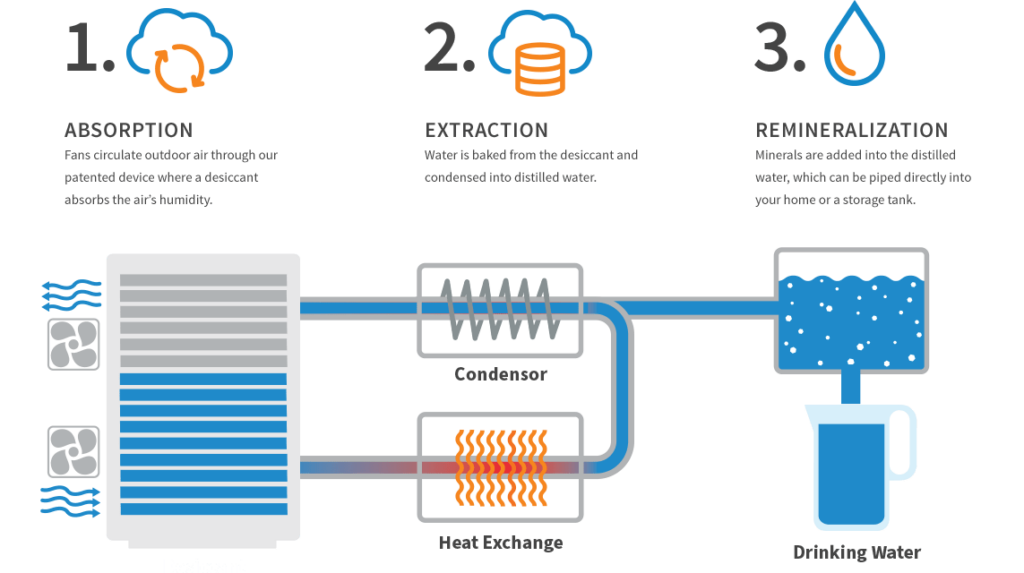INTRODUCTION:

Atmospheric Water Generation (AWG) technology refers to the process of producing water by extracting moisture from the air. As the world faces increasing water scarcity, AWG provides a sustainable and innovative solution to meet the growing demand for clean water, particularly in areas where freshwater resources are limited, polluted, or inaccessible.
AWG systems capture water vapor present in the atmosphere, condense it into liquid water, and purify it for use in drinking, irrigation, and other purposes. This technology operates on the principle that the air around us contains water in the form of vapor, and with the right equipment, this moisture can be converted into potable water.
TECHNOLOGY USED:
1. Cooling Condensation
This is one of the most common and widely used methods of atmospheric water generation. It works on the principle of cooling air to its dew point so that the water vapor in the air condenses into liquid water. The process is similar to how moisture collects on a cold surface, such as a glass of cold water on a warm day.
2. Desiccant-Based Systems
Desiccants are materials that absorb moisture from the air. These materials can be natural (e.g., silica gel) or synthetic. Once the desiccant material absorbs moisture, heat is applied to release the water, which is then collected, filtered, and purified.
3. Solar-Powered Atmospheric Water Generators (Solar AWG)
Solar-powered AWGs integrate renewable energy sources into the water generation process, significantly reducing the environmental impact of traditional AWG systems. These systems are typically used in areas with abundant sunlight and are designed to work off-grid.
4. Hydrophilic (Water-Attracting) Materials
Recent research in AWG has focused on hydrophilic materials that can attract and absorb water vapor from the air. These materials are used in advanced AWG systems to increase efficiency.
5. Thermo-Electric Systems (TEG)
Thermoelectric systems use the principle of thermoelectrics to generate water from air by utilizing temperature differences to drive condensation. This method requires a heat exchange between two materials with different temperatures, causing moisture in the air to condense.
6. Reverse Osmosis (RO) and Filtration
Once water is extracted from the air, it often undergoes additional purification processes to ensure it’s safe for consumption. Reverse Osmosis (RO) is a common method for purifying extracted water, where water is forced through a semipermeable membrane that filters out impurities and contaminants.
7. Electrostatic Precipitation
Electrostatic precipitation is a less common but emerging method for water generation. It uses an electrostatic charge to attract water molecules from the air. When air passes through an electric field, the water vapor condenses onto electrodes and is then collected
ADVANTAGE:
- Cost-efficient: AWGs are cheaper than other water sources like desalination.
- Clean water: AWGs produce water that’s free of contaminants and chemicals, similar to distilled water.
- No harmful emissions: AWGs don’t produce pollutants or wastewater.
- Reduces plastic pollution: AWGs can eliminate the need for bottled water and plastic.
DISADVANTAGE:
- Electricity consumption: AWGs use more electricity than well pumps.
- Water collection speed: Water collection needs to happen quickly, or the water will evaporate.
- Practicality: AWGs may not produce enough water for large populations or areas with limited access to other water sources.
- Maintenance: AWGs may require trained professional operators.
USES:
1. AWG systems are widely used to produce clean and safe drinking water.
2.AWG technology can be used to produce water for agricultural purposes, particularly in arid and semi-arid regions where groundwater is scarce or overused.
3. AWG can be used in manufacturing plants that rely on high-quality water for production, such as in pharmaceuticals, food processing, and electronics manufacturing.
4. AWG can be used by military personnel in remote or desert regions where water supply is limited.

HOW IT WORKS:
Atmospheric water generation technology, also known as an Atmospheric Water Generator (AWG), extracts water vapor from the air by cooling it below its dew point, causing the water vapor to condense into liquid water that can be collected and consumed; essentially, it works like a dehumidifier, pulling moisture from the air by passing it over a cold surface, allowing the water vapor to condense and be collected as liquid water, typically using a refrigeration cycle to achieve the necessary cooling.

- Air intake:Ambient air is drawn into the device by a fan.
- Cooling process:The air is then passed over a cold evaporator coil, which is cooled by a refrigerant circulating through the system. This cooling process lowers the air temperature below its dew point, causing water vapor to condense into tiny droplets.
- Condensation collection:The condensed water droplets are collected on the surface of the evaporator coil and drip into a collection container.
- Refrigerant cycle:The refrigerant absorbs heat from the air in the evaporator, then moves to a compressor where it is pressurized and heated, allowing it to release this heat in the condenser, which cools the air further in the evaporator cycle.
- Filtration:The collected water is usually filtered to remove any impurities before being stored for use.

